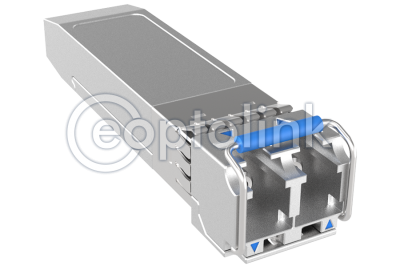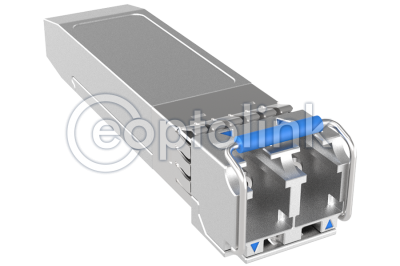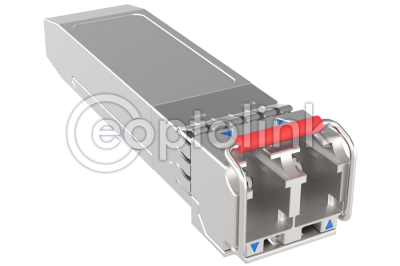Fiber Optic Transport of HD/SD-SDI It is becoming increasingly necessary and economically feasible to transport HD/SD-SDI signals over fiber instead of coaxial cable. The reasons are many including increased bandwidth, lower cabling cost, noise immunity and greater transmission distances. Prior to 2006, several standards were used to define how SDI signals were to be transported over fiber. Now, there is one standard to define the many aspects and parameters of the fiber optic interface for the transmission and reception of SDI over fiber. SMPTE 297-2006: This standard defines the fiber optic interface for the transmission and reception of SDI signals at various data rates: 12G, 6G, SMPTE 259M: 143 through 360 Mbps SMPTE 344M: 540 Mbps SMPTE 292: 1.485 and 1.485/1.001 Gbps SMPTE 424M: 2.97 and 2.97/1.001 Gbps SMPTE 297-2006 defines many parameters of the optical interface for both a transmitting and receiving device with a fiber optic interface. The input to a fiber Transmitter can be any one of the SMPTE coaxial-based standards indicated above. On the Receiver, the output will be of the same coaxial interface type of the Transmitter. The significance of the new 297 standard is that it allows for interoperability between fiber optic devices from different manufacturers that comply with the standard.
Video SMPTE SFP
Fiber Optic Transport of HD/SD-SDI
It is becoming increasingly necessary and economically feasible to transport HD/SD-SDI signals over fiber instead of coaxial cable. The reasons are many including increased bandwidth, lower cabling cost, noise immunity and greater transmission distances. Prior to 2006, several standards were used to define how SDI signals were to be transported over fiber. Now, there is one standard to define the many aspects and parameters of the fiber optic interface for the transmission and reception of SDI over fiber.
SMPTE 297-2006: This standard defines the fiber optic interface for the transmission and reception of SDI signals at various data rates: 3G ~ 12G
SMPTE 259M: 143 through 360 Mbps
SMPTE 344M: 540 Mbps
SMPTE 292: 1.485 and 1.485/1.001 Gbps
SMPTE 424M: 2.97 and 2.97/1.001 Gbps
SMPTE 297-2006 defines many parameters of the optical interface for both a transmitting and receiving device with a fiber optic interface. The input to a fiber Transmitter can be any one of the SMPTE coaxial-based standards indicated above. On the Receiver, the output will be of the same coaxial interface type of the Transmitter. The significance of the new 297 standard is that it allows for interoperability between fiber optic devices from different manufacturers that comply with the standard.
Video and Studio equipment
SMPTE 12G Digital Video Transceiver, Single TX, Single RX, Dual RX, Dual TX
| P/N | Package | Data Rate | Temperature | Module Type | MSA |
| 12G Video Transceiver SFP+ | |||||
| EOLP-1312G-10-RXX | SFP+ | 0.27~11.88Gbps | C | Transceiver | MSA |
| EOLP-1312G-10-RNXX | SFP+ | 0.27~11.88Gbps | C | Transceiver | NON-MSA |
| EOLP-1612G-14XRXX | CWDM SFP+ | 0.27~11.88Gbps | C | Transceiver | MSA |
| EOLP-1612G-14XRNXX | CWDM SFP+ | 0.27~11.88Gbps | C | Transceiver | NON-MSA |
| 12G Video Receiver SFP+ | |||||
| EOLP-12G-R-RXX | SFP+ | 0.27~11.88Gbps | C | Single receiver | MSA |
| EOLP-12G-R-RNXX | SFP+ | 0.27~11.88Gbps | C | Single receiver | NON-MSA |
| EOLP-12G-DR-RNXX | SFP+ | 1.485~11.88Gbps | C | Dual receiver | NON-MSA |
| 12G Video Transmitter SFP+ | |||||
| EOLP-1312G-T-10-R | SFP+ | 0.27~11.88Gbps | C | Single transmitter | MSA |
| EOLP-1312G-T-10-RN | SFP+ | 0.27~11.88Gbps | C | Single transmitter | NON-MSA |
| EOLP-1312G-DT-10-RN | SFP+ | 1.485~11.88Gbps | C | Dual transmitter | NON-MSA |
| EOLP-1612G-T-XR | CWDM SFP+ | 0.27~11.88Gbps | C | Single transmitter | MSA |
| EOLP-1612G-T-XRN | CWDM SFP+ | 0.27~11.88Gbps | C | Single transmitter | NON-MSA |
| EOLP-1612G-DT-XYRN | CWDM SFP+ | 1.485~11.88Gbps | C | Dual transmitter | NON-MSA |
When XX=PS (only for transceiver and receiver) represents it supports pathological signals. When XX=blank (only for transceiver and receiver) represents it doesn't support pathological signals. No CDR version (replace "R" in PN with "V") for application when there is CDR in host side.
For the latest specification and samples, please, contact us This email address is being protected from spambots. You need JavaScript enabled to view it.
SMPTE 6G Digital Video Transceiver, Single TX, Single RX, Dual RX, Dual TX
| P/N | Package | Data Rate | Temperature | Module Type | MSA |
| 6G Video Transceiver SFP+ | |||||
| EOLS-1360-10-VXX | SFP+ | 0.27~5.94Gbps | C | Transceiver | MSA |
| EOLS-1360-10-VNXX | SFP+ | 0.27~5.94Gbps | C | Transceiver | NON-MSA |
| EOLS-1660-14XVXX | CWDM SFP+ | 0.27~5.94Gbps | C | Transceiver | MSA |
| EOLS-1660-14XVNXX | CWDM SFP+ | 0.27~5.94Gbps | C | Transceiver | NON-MSA |
| 6G Video Receiver SFP+ | |||||
| EOLS-60-R-VXX | SFP+ | 0.27~5.94Gbps | C | Single receiver | MSA |
| EOLS-12G-R-VNXX | SFP+ | 0.27~5.94Gbps | C | Single receiver | NON-MSA |
| EOLS-12G-DR-VNXX | SFP+ | 0.27~5.94Gbps | C | Dual receiver | NON-MSA |
| 6G Video Transmitter SFP+ | |||||
| EOLS-1360-T-10-V | SFP+ | 0.27~5.94Gbps | C | Single transmitter | MSA |
| EOLS-1360-T-10-VN | SFP+ | 0.27~5.94Gbps | C | Single transmitter | NON-MSA |
| EOLS-1360-DT-10-VN | SFP+ | 0.27~5.94Gbps | C | Dual transmitter | NON-MSA |
| EOLS-1660-T-XV | CWDM SFP+ | 0.27~5.94Gbps | C | Single transmitter | MSA |
| EOLS-1660-T-XVN | CWDM SFP+ | 0.27~5.94Gbps | C | Single transmitter | NON-MSA |
| EOLS-1660-DT-XYVN | CWDM SFP+ | 0.27~5.94Gbps | C | Dual transmitter | NON-MSA |
When XX=PS (only for transceiver and receiver) represents it supports pathological signals. When XX=blank (only for transceiver and receiver) represents it doesn't support pathological signals.
For the latest specification and samples, please, contact us This email address is being protected from spambots. You need JavaScript enabled to view it.




